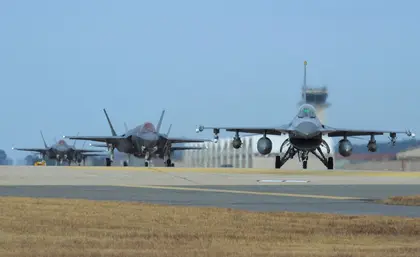The leadership of the U.S. Air Force has taken the confident course of upgrading its military air fleet. To make room, the U.S. military plans to retire about 310 of its current military aircraft through to 2024.
Most of these aircraft are in good working order and have not exhausted their flight capacity. Such aircraft are typically kept in special storage facilities in the desert where the lack of precipitation contributes to longer-term preservation. They are also used as donors of spare parts to repair those aircraft that remain in service. The retirement of a significant number will free up funds for modernization, maintenance, and the purchase of new aircraft.
JOIN US ON TELEGRAM
Follow our coverage of the war on the @Kyivpost_official.
With these savings, the U.S. Air Force plans to purchase 72 fighter planes in 2024. The new models are expected to include 48 F-35As and 24 F-15EXs. Also, senior leaders intend to continue working on promising projects such as the new B-21 Raider bomber, Boeing E-7A AWACS aircraft and others.
The plan to decommission 310 aircraft by 2024 could be considered bold. By way of comparison, this year the U.S. Air Force planned to retire 150 aircraft, but Congress only approved 115.
The well-known A-10 attack aircraft is scheduled to be completely decommissioned by 2028-2029. In 2024, 42 of these aircraft will be retired, and another 21 are set to be decommissioned this year. A further 57 F-15 C and D fighters are also on the list.

US Embassy in Kyiv to Reopen After Threat of Attack
Along with the F-15, the leadership has taken the initiative to retire 32 F-22A Raptor Block 2 fighters. These aircraft are no longer operational and are primarily used for training military pilots. Last year, a proposal was made to retire the planes, but Congress blocked it. Instead, the plan is to replace them with new F-35s and F-15EXs.
In addition to the aircraft retirement plan, the U.S. Air Force also plans to decommission 2 E-3 Sentry aircraft, 24 KC-10 Extender refueling tankers, 48 MQ-9 Reaper Block 1 drones, three E-8 Joint Surveillance Target Attack Radar Systems, 37 HH-60G Pave Hawk helicopters, 52 T-1 Jayhawk trainers and one B-1B Lancer bomber.
One cannot exclude the possibility that, after decommissioning, some of these aircraft may be transferred to Ukraine. The most interesting to consider are the A-10 attack aircraft, F-15 fighters and MQ-9 Reaper attack drones.
A-10 Thunderbolt II or "Warthog"
The A-10 Thunderbolt II is one of the oldest aircraft still in service with the U.S. Air Force. In fact, it has been trying to retire these legendary attack planes for about a decade. The U.S. Air Force plans to decommission all 260 aircraft by 2028 and cease spending on their ongoing modernization. The command believes that A-10s are of great importance for ground forces but are not effective enough for air combat operations against Russian or Chinese aircraft.
The A-10 was developed for war with the U.S.S.R in conditions of full-scale conflict and has remained in service for more than half a century. These aircraft have heavy armor, formidable weapons, and two engines. On the battlefield, all these parameters make this machine as efficient and survivable as possible.
During Operation Desert Storm in 1990-1991, the A-10s proved their resilience by destroying about 900 Soviet-made Iraqi tanks, 1,200 artillery systems, and 2,000 other vehicles. Often, they would return to their bases after being severely damaged. The aircraft remains in service with the U.S. Air Force due to its excellent survivability, ease of maintenance, low cost of operation, and proven combat effectiveness.
Some military experts and officials claim that the A-10 is not suitable for Ukraine on the basis that these aircraft are used to operating in the absence of enemy aircraft and air defense systems.
But we shouldn't forget that, right now, Ukrainian pilots are flying Su-25s in the skies above Ukraine every day. They successfully carry out combat missions despite the presence of Russian fighters and air defense systems. The Su-25 is a direct Soviet analog of the A-10.
The A-10 armament
One of the A-10's key strengths is its full arsenal of NATO precision weapons, which the Soviet Su-25 lacks. The A-10 can be armed with AGM-65 Maverick anti-tank missiles with a range of about 30 kilometers and a “fire and forget” principle. The attack aircraft is also capable of dropping precision-guided JDAM munitions and firing a 30-mm seven-barrel GAU-8 Avenger gun, which has a rate of fire of 3,900 rounds per minute.
The armor penetration of this gun is enough to destroy enemy BMPs and armored personnel carriers. Also, the maximum combat load for the "Warthog" (the name given to it by the military because of the characteristic outline of the seven-barrel gun) is 7,260 kilograms, which is almost twice the capacity of the Soviet Su-25 "Rook", which can carry up to 4,400 kilograms.
The A-10 has another significant advantage: it can be based on unpaved airfields and does not require large and high-quality runways. This allows it to operate in poorly accessible areas and on the front line. In addition, field maintenance of the aircraft is greatly simplified, as many components are interchangeable. For example, the engines and vertical stabilizers can be replaced from the right to the left side of the aircraft and vice versa.
This attack aircraft would be a reliable and effective means of supporting ground operations of the Armed Forces of Ukraine (AFU).
MQ-9 Reaper
The U.S. also plans to retire 48 MQ-9 Reaper Block 1 drones. This represents one of the first modifications of this UAV, which is now about 20 years old. The military's desire to abandon outdated drones is understandable, as the Department of Defense tested an improved version, the Reaper Block 1+ back in 2012. Since 2017, the U.S. Air Force has been using Block 5 drones. So, even though the Block 1 is the first modification, as a strike drone it is still a very serious tool.
The MQ-9 Reaper is the U.S. Army's main strike drone and one of the most advanced reconnaissance and strike UAVs in the world. It has significantly greater capabilities and characteristics than the well-known Bayraktar TB2 in Ukraine. Besides the U.S., these drones are in service with the air forces of the United Kingdom, Italy, Mexico, Portugal, Turkey, and other countries.
The first modification of this drone can stay in the air continuously for about 28 hours and boasts a maximum payload of 1.7 tons. It can move at a speed of up to 482 kilometers per hour and climb to an altitude of 15,420 meters, with an operating altitude of 7.5 kilometers. The Reaper has a range of 1,900 km, seven points for suspension, and can be equipped with AGM-114 Hellfire missiles, as well as GBU-12 Paveway and GBU-38 JDAM bombs. Compared to the well-known Ukrainian Bayraktar TB2, the Reaper is significantly superior in terms of characteristics and capabilities.
Significant potential
Even a cursory inspection of aircraft scheduled for retirement in the U.S. shows its significant potential on the battlefield. In the context of the AFU’s offensive campaigns, the A-10 attack aircraft and the MQ-9 Reaper drone are capable of performing important missions to destroy Russian armored vehicles, air defense systems, and manpower concentrations.
The ability of these aircraft to conduct precision strikes on enemy military targets would allow the AFU to conduct effective de-occupation operations and save the lives of many military and civilians. But, of course, the transfer of this type of attack aircraft and UAVs requires a political decision by the U.S. government.
The views expressed are the author’s and not necessarily of Kyiv Post.
You can also highlight the text and press Ctrl + Enter






